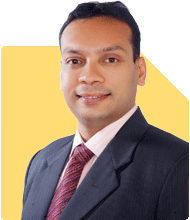Ramalingam Kalirajan |6501 Answers |Ask -Follow
Mutual Funds, Financial Planning Expert - Answered on Jul 06, 2024
He has an MBA in finance from the University of Madras and is a certified financial planner.
He is the director and chief financial planner at Holistic Investment, a Chennai-based firm that offers financial planning and wealth management advice.... more

My age is 52: holding 2.5 cr mf 1 cr ppf/pf and 3 cr shares .. is this investment ok for reimbursement...or need to divert these funds for retirement . retirement age around 55-58
Understanding Your Current Investment Portfolio
Your portfolio is well-diversified across mutual funds, PPF/PF, and shares. This diversification helps balance risk and reward. Let’s analyze each component.
Mutual Funds (Rs. 2.5 Crore)
You have a substantial investment in mutual funds, which is excellent for long-term growth. Mutual funds are managed by professionals and offer diversification, which reduces risk.
Public Provident Fund/Provident Fund (Rs. 1 Crore)
PPF and PF are safe, government-backed investments offering steady returns. They are excellent for risk-averse investors and provide tax benefits.
Shares (Rs. 3 Crore)
Investing in shares indicates you’re comfortable with higher risk for potentially higher returns. Shares can offer significant growth but require careful management to mitigate market volatility.
Evaluating Your Retirement Needs
As you plan for retirement around 55-58, consider your retirement corpus needs. Estimate your post-retirement expenses, factoring in inflation, medical costs, and lifestyle needs. A common rule of thumb is to have 20-25 times your annual expenses saved for retirement.
Rebalancing Your Portfolio
Given your age and proximity to retirement, it’s crucial to reassess and possibly rebalance your portfolio. Here’s how:
1. Increase Fixed Income Investments
As you near retirement, shifting some investments to fixed-income options like debt funds or bonds can provide stability and regular income.
Benefits of Fixed Income Investments
Stability: Less volatile than equities.
Regular Income: Provides consistent returns.
Capital Preservation: Protects your principal investment.
2. Review Equity Exposure
With Rs. 3 crore in shares, you have a high exposure to equities. While this offers growth potential, it also comes with market risk. Gradually reducing equity exposure and shifting to safer assets can protect your corpus.
Risk Management in Shares
Diversify: Spread investments across various sectors.
Review Regularly: Monitor performance and market conditions.
Consider Blue-Chip Stocks: Invest in well-established companies with stable returns.
3. Continue with Mutual Funds
Mutual funds should remain a significant part of your portfolio. However, consider shifting from high-risk equity funds to balanced or debt-oriented funds.
Types of Mutual Funds
Balanced Funds: Mix of equity and debt, offering moderate risk and returns.
Debt Funds: Focus on fixed income securities, providing stable returns with lower risk.
Equity Funds: High growth potential but higher risk. Suitable for long-term goals.
Systematic Withdrawal Plan (SWP)
SWP can be a strategic tool to generate regular income from your mutual fund investments during retirement.
Benefits of SWP
Regular Income: Provides a steady cash flow.
Capital Preservation: Only a part of the investment is withdrawn, leaving the rest to grow.
Tax Efficiency: Only the gains portion is taxed, which can be more tax-efficient than regular income.
Power of SWP
SWP harnesses the power of compounding and market growth. By withdrawing only a portion, your principal amount continues to earn returns. This can provide a sustainable income stream over a long period.
Tax Planning for Retirement
Effective tax planning can enhance your post-retirement income.
Utilize Tax-Advantaged Accounts
Maximize your contributions to PPF and PF to take advantage of tax benefits.
Plan Withdrawals Wisely
Strategize withdrawals from various accounts to minimize tax liability. For example, PPF withdrawals are tax-free.
Health Insurance and Medical Expenses
Medical costs can be significant during retirement. Ensure you have adequate health insurance to cover unexpected medical expenses.
Review Health Insurance
Evaluate your current health insurance and consider increasing coverage if necessary.
Build a Medical Fund
Set aside a portion of your investments specifically for medical emergencies.
Estate Planning
Estate planning ensures your assets are distributed as per your wishes.
Draft a Will
Create a will to specify asset distribution. This prevents legal complications and ensures your wishes are honored.
Appoint Nominees
Appoint nominees for your bank accounts, insurance policies, and investments. This simplifies the transfer of assets in case of your absence.
Emergency Fund
Maintain an emergency fund to cover 6-12 months of expenses. This provides financial security in case of unforeseen events.
Regular Review and Rebalancing
Regularly review your investment portfolio. Rebalance it annually to maintain the desired asset allocation and achieve optimal returns.
Importance of Professional Guidance
Consult a Certified Financial Planner (CFP) for personalized advice. A CFP can help you create a tailored retirement plan and ensure your investments align with your goals.
Advantages of Actively Managed Funds
Actively managed funds are controlled by fund managers who make strategic decisions. Here’s why they are beneficial:
Flexibility: Managers can adapt to market changes.
Potential for Higher Returns: Can outperform the market.
Risk Management: Fund managers can mitigate risks.
Disadvantages of Index Funds
Index funds mimic the performance of a market index. Here are some disadvantages:
Lack of Flexibility: Cannot adapt to market changes.
Market Risk: Exposed to the entire market’s ups and downs.
Lower Returns: May not outperform actively managed funds.
Disadvantages of Direct Funds
Direct funds have no intermediary, so you save on commission. However, there are drawbacks:
Lack of Guidance: No professional advice.
Time-Consuming: Requires constant monitoring.
Higher Risk: Without expert advice, the risk of poor decisions increases.
Benefits of Regular Funds through CFP
Investing through a Certified Financial Planner (CFP) offers several benefits:
Professional Advice: Expert guidance on fund selection.
Regular Monitoring: Continuous review and adjustments.
Tailored Portfolio: Customized investment strategy based on your goals.
Power of Compounding
The power of compounding is a critical aspect of wealth creation. It allows your investments to grow exponentially over time.
Example of Compounding
Investing Rs. 10,000 monthly at an average annual return of 12% for 20 years can significantly grow your wealth due to compounding.
Creating a Sustainable Retirement Plan
A well-rounded retirement plan includes a mix of growth, income, and safety. Here’s a step-by-step approach:
1. Assess Your Current Situation
Evaluate your current assets, liabilities, income, and expenses. This helps in understanding your financial standing.
2. Define Your Retirement Goals
Determine your retirement lifestyle, estimated expenses, and desired retirement age. This helps in setting clear financial goals.
3. Develop an Investment Strategy
Create an investment strategy that balances growth and safety. Include a mix of equity, debt, and fixed-income investments.
4. Plan for Inflation
Inflation erodes purchasing power. Ensure your investments grow at a rate higher than inflation to maintain your lifestyle.
5. Create Multiple Income Streams
Diversify your income sources to reduce dependency on a single source. This includes SWP, dividends, and interest income.
6. Regularly Review and Adjust
Monitor your investments and adjust your strategy as needed. This ensures your portfolio remains aligned with your goals.
Final Insights
You have done a fantastic job building a strong investment portfolio. As you approach retirement, consider rebalancing your portfolio to reduce risk and ensure a steady income. Consult a Certified Financial Planner (CFP) to create a personalized retirement plan. Stay disciplined, focused, and regularly review your investments to enjoy a comfortable and financially secure retirement.
Best Regards,
K. Ramalingam, MBA, CFP,
Chief Financial Planner,
www.holisticinvestment.in
Gradual Shift: Gradually reduce your equity exposure by moving a portion of your investments into safer debt instruments like debt mutual funds, bonds, or FDs. Aim to achieve a balance that matches your risk tolerance and income needs.
Systematic Withdrawal Plan (SWP): Utilize SWP in mutual funds to create a steady income stream. This allows you to withdraw a fixed amount regularly while keeping the remaining funds invested and growing.
Laddering FDs: If you choose FDs, consider laddering them to manage interest rate risks and ensure liquidity.
Consult a financial planner to tailor this strategy to your specific needs, ensuring a balance between security and growth.
Best Regards,
K. Ramalingam, MBA, CFP,
Chief Financial Planner,
www.holisticinvestment.in
You may like to see similar questions and answers below
Ramalingam Kalirajan |6501 Answers |Ask -Follow
Mutual Funds, Financial Planning Expert - Answered on Apr 20, 2024
Ramalingam Kalirajan |6501 Answers |Ask -Follow
Mutual Funds, Financial Planning Expert - Answered on May 10, 2024
Ramalingam Kalirajan |6501 Answers |Ask -Follow
Mutual Funds, Financial Planning Expert - Answered on May 15, 2024
Ramalingam Kalirajan |6501 Answers |Ask -Follow
Mutual Funds, Financial Planning Expert - Answered on Jul 12, 2024
Dr Dipankar Dutta |653 Answers |Ask -Follow
Tech Careers and Skill Development Expert - Answered on Oct 04, 2024
Krishna Kumar |377 Answers |Ask -Follow
Workplace Expert - Answered on Oct 04, 2024
Krishna Kumar |377 Answers |Ask -Follow
Workplace Expert - Answered on Oct 04, 2024
Krishna Kumar |377 Answers |Ask -Follow
Workplace Expert - Answered on Oct 04, 2024
Krishna Kumar |377 Answers |Ask -Follow
Workplace Expert - Answered on Oct 04, 2024
Krishna Kumar |377 Answers |Ask -Follow
Workplace Expert - Answered on Oct 04, 2024
Krishna Kumar |377 Answers |Ask -Follow
Workplace Expert - Answered on Oct 04, 2024
Krishna Kumar |377 Answers |Ask -Follow
Workplace Expert - Answered on Oct 04, 2024
Krishna Kumar |377 Answers |Ask -Follow
Workplace Expert - Answered on Oct 04, 2024
Krishna Kumar |377 Answers |Ask -Follow
Workplace Expert - Answered on Oct 04, 2024
























